clutch HONDA CIVIC HYBRID 2003 7.G Owners Manual
[x] Cancel search | Manufacturer: HONDA, Model Year: 2003, Model line: CIVIC HYBRID, Model: HONDA CIVIC HYBRID 2003 7.GPages: 317, PDF Size: 4.17 MB
Page 144 of 317
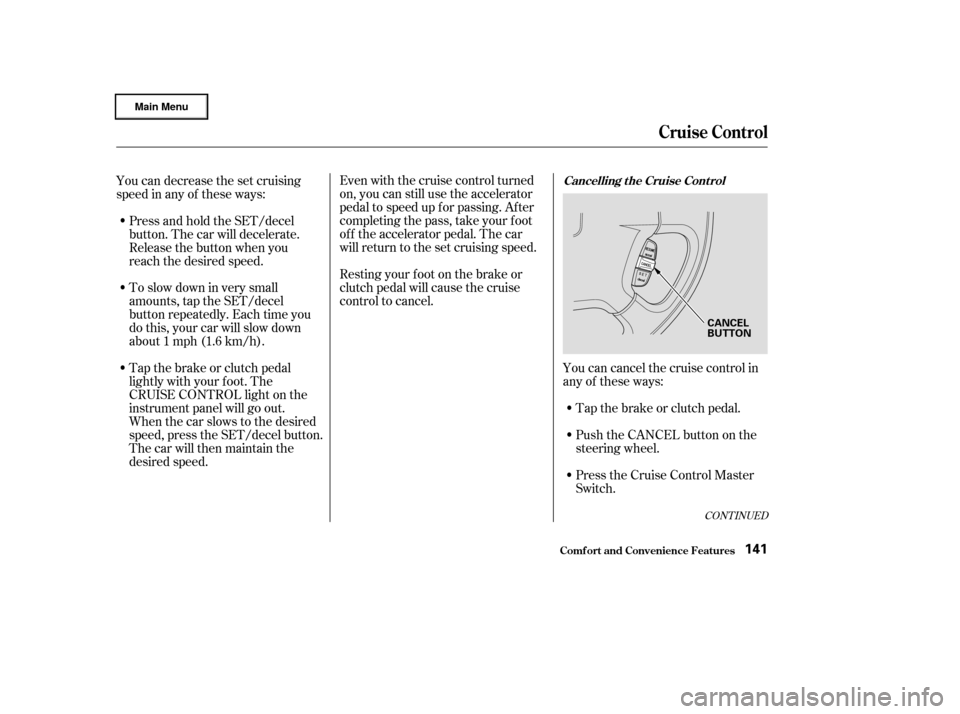
Even with the cruise control turned
on, you can still use the accelerator
pedal to speed up f or passing. Af ter
completing the pass, take your foot
of f the accelerator pedal. The car
will return to the set cruising speed.
Resting your f oot on the brake or
clutch pedal will cause the cruise
control to cancel.
You can decrease the set cruising
speed in any of these ways:
Press and hold the SET/decel
button. The car will decelerate.
Release the button when you
reach the desired speed.
To slow down in very small
amounts, tap the SET/decel
button repeatedly. Each time you
do this, your car will slow down
about 1 mph (1.6 km/h).
Tap the brake or clutch pedal
lightly with your f oot. The
CRUISE CONTROL light on the
instrument panel will go out.
When the car slows to the desired
speed, press the SET/decel button.
The car will then maintain the
desired speed. Tap the brake or clutch pedal.
Youcancancelthecruisecontrolin
any of these ways:
Push the CANCEL button on the
steering wheel.
Press the Cruise Control Master
Switch.
CONT INUED
Cancelling t he Cruise Cont rol
Cruise Control
Comf ort and Convenience Feat ures141
CANCEL
BUTTON
Page 145 of 317

When you push the CANCEL button,
or tap the brake or clutch pedal, the
CRUISE CONTROL light on the
instrument panel will go out and the
car will begin to slow down. You can
use the accelerator pedal in the
normal way.
The system remembers the
previously-set cruising speed. To
return to that speed, accelerate to
above25mph(40km/h),thenpress
the RESUME/accel button. The
CRUISE CONTROL light comes on,
and the car will accelerate to the
same cruising speed as bef ore.Pressing the Cruise Control Master
Switch turns the system completely
of f and erases the previous cruising
speed f rom memory. To use the
system again, ref er to
.
Cruise Control
Comf ort and Convenience Feat ures
Using t he
Cruise Cont rol
142
Page 164 of 317

If the engine does not start within
15 seconds, or starts but stalls
right away, repeat step 4 with the
accelerator pedal pressed half-way
down. If the engine starts, release
pressure on the accelerator pedal
so the engine does not race.
If the engine still does not start,
press the accelerator pedal all the
way down and hold it there while
starting in order to clear f looding.
As bef ore, keep the ignition key in
the START (III) position f or no
more than 15 seconds. Return to
step 5 if the engine does not start.
If it starts, lif t your f oot of f the
accelerator pedal so the engine
does not race.
Apply the parking brake.
In cold weather, turn of f all
electrical accessories to reduce
the drain on the battery.
Push the clutch pedal down all the
way. START (III) does not
f unction unless the clutch pedal is
depressed.
Make sure the shif t lever is in
Park. Press on the brake pedal.
Without touching the accelerator
pedal, turn the ignition key to the
START (III) position. If the engine
does not start right away, do not
hold the key in START (III) f or
more than 15 seconds at a time.
Pause f or at least 10 seconds
bef ore trying again.
An engine is harder to start in cold
weather. The thinner air f ound at
high altitude above 8,000 f eet (2,400 meters) adds to the problem.
Use the f ollowing procedure:
Turn of f all electrical accessories
to reduce the drain on the battery.
Push the accelerator pedal half-
way to the f loor and hold it there
while starting the engine. Do not
hold the ignition key in START
(III) f or more than 15 seconds.
When the engine starts, release
the accelerator pedal gradually as
the engine speeds up and smooths
out.
If the engine fails to start in step 2,
push the accelerator pedal to the
f loor and hold it there while you
try to start the engine for no more
than 15 seconds. If the engine
does not start, return to step 2.
1.
2.
3.
4.
5.
6.
1.
2.
3.
Manual Transmission:
Automatic Transmission (CVT):
Starting the Engine
Driving
Starting in Cold Weather at High
A ltitude (A bove 8,000 f eet/
2,400 meters)
161
Page 165 of 317
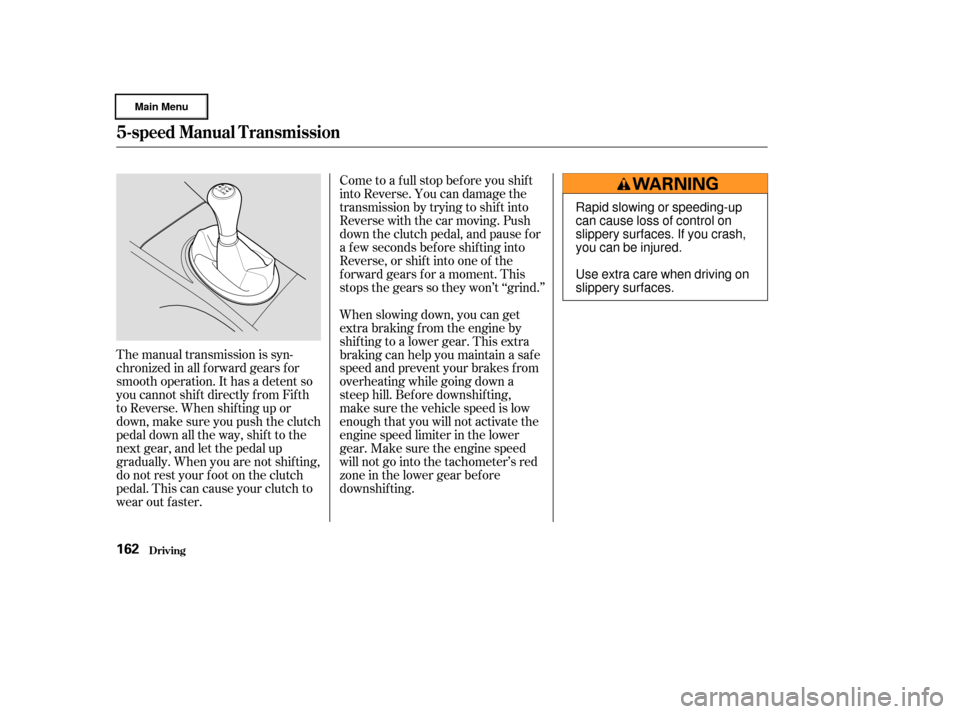
Come to a full stop before you shift
into Reverse. You can damage the
transmission by trying to shif t into
Reverse with the car moving. Push
down the clutch pedal, and pause f or
a f ew seconds bef ore shif ting into
Reverse, or shif t into one of the
f orward gears f or a moment. This
stops the gears so they won’t ‘‘grind.’’
The manual transmission is syn-
chronizedinallforwardgearsfor
smooth operation. It has a detent so
you cannot shift directly from Fifth
to Reverse. When shif ting up or
down,makesureyoupushtheclutch
pedal down all the way, shift to the
next gear, and let the pedal up
gradually. When you are not shif ting,
do not rest your f oot on the clutch
pedal. This can cause your clutch to
wear out faster. When slowing down, you can get
extra braking f rom the engine by
shifting to a lower gear. This extra
braking can help you maintain a safe
speed and prevent your brakes f rom
overheating while going down a
steep hill. Bef ore downshif ting,
make sure the vehicle speed is low
enough that you will not activate the
engine speed limiter in the lower
gear. Make sure the engine speed
will not go into the tachometer’s red
zone in the lower gear bef ore
downshif ting.
5-speed Manual T ransmission
Driving162
Rapid slowing or speeding-up
can cause loss of control on
slippery surfaces. If you crash,
you can be injured.
Use extra care when driving on
slippery surfaces.
Page 166 of 317

The engine coolant is nearly up to
normal operating temperature.
The vehicle’s speed is below 19
mph (30 km/h) and you are
pressing on the brake pedal to
come to a stop.
You depress the clutch pedal.
You are not pressing on the
accelerator pedal.During Auto Idle Stop, the IMA
charge and power brake vacuum
reserve is monitored by the system.
If either drops below a desired level,
and the shif t lever is in Neutral, the
engine will restart so it can recharge
the IMA battery or replenish the
vacuum supply.
To maximize f uel economy, your
Civic Hybrid has an Auto Idle Stop
f unction. Under certain conditions,
the engine will shut of f when you
come to a stop. Those conditions are:
The IMA battery is charged
enough to operate the system.
The ECON mode is selected, and
the outside temperature is above
41°F (5°C), or the f an speed controldialisoff (seepage ).
There is adequate vacuum reserve
f or the power brakes.
When these conditions are met, the
engine will shut of f as you come to a
stop. It will start again automatically
when you depress the clutch pedal
and move the shif t lever to f irst gear.
There is no need to start the engine
with the ignition switch.
It is recommended that you move
the shift lever to Neutral and remove
your f oot f rom the clutch pedal while
you are stopped. Sitting with the
clutch pedal depressed and the shif t
lever in gear will cause the engine to
continue running, def eating the f uel
economy benef its of the Auto Idle
Stop f unction. The Auto Idle Stop f unction may not
activate when starting the engine or
if the IMA battery temperature is too
hot or too cold.
111
CONT INUED
5-speed Manual T ransmission
Driving
Auto Idle Stop
163
Page 167 of 317
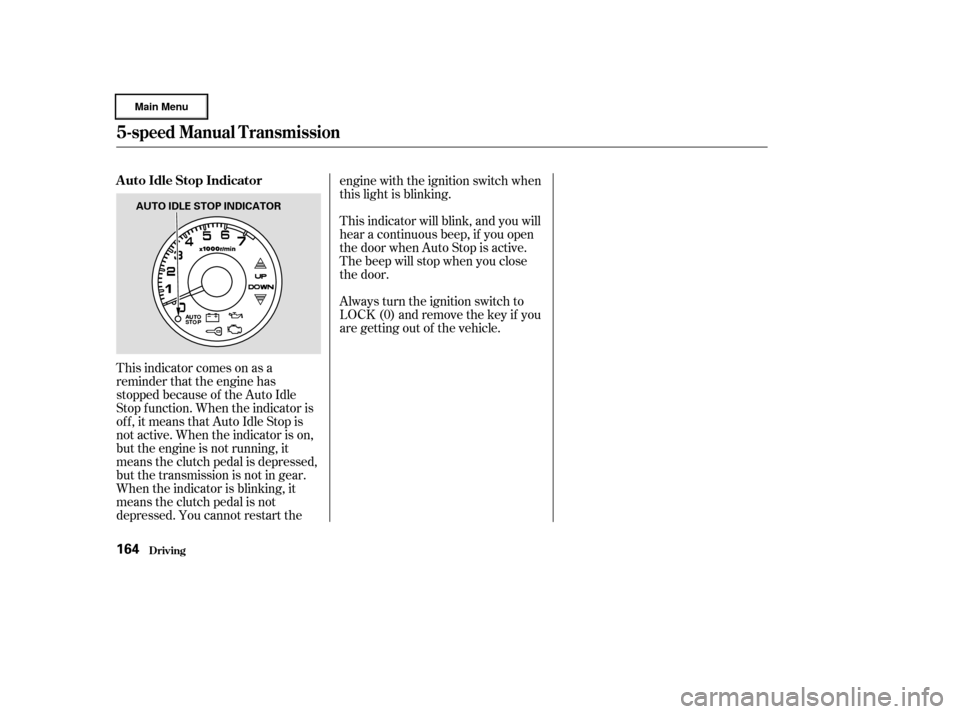
This indicator comes on as a
reminder that the engine has
stopped because of the Auto Idle
Stop f unction. When the indicator is
of f , it means that Auto Idle Stop is
not active. When the indicator is on,
but the engine is not running, it
means the clutch pedal is depressed,
but the transmission is not in gear.
When the indicator is blinking, it
means the clutch pedal is not
depressed. You cannot restart theengine with the ignition switch when
this light is blinking.
This indicator will blink, and you will
hear a continuous beep, if you open
the door when Auto Stop is active.
The beep will stop when you close
the door.
Always turn the ignition switch to
LOCK (0) and remove the key if you
are getting out of the vehicle.
5-speed Manual T ransmission
Driving
A uto Idle Stop Indicator
164
AUTO IDLE STOP INDICATOR
Page 184 of 317
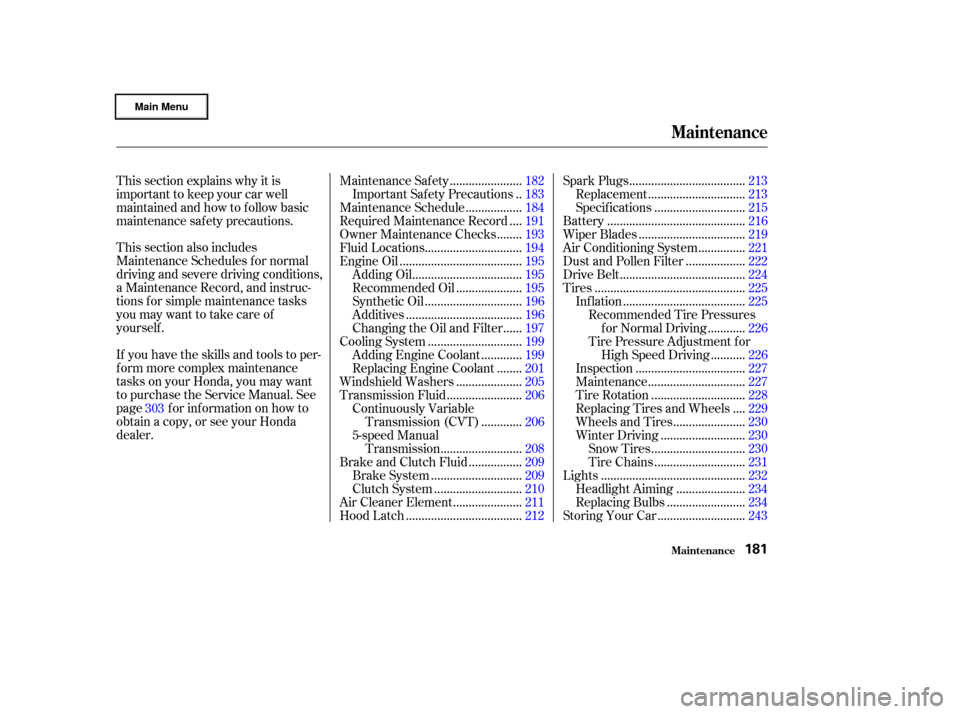
This section also includes
Maintenance Schedules f or normal
driving and severe driving conditions,
a Maintenance Record, and instruc-
tions f or simple maintenance tasks
you may want to take care of
yourself .
If you have the skills and tools to per-
f orm more complex maintenance
tasks on your Honda, you may want
to purchase the Service Manual. See
page f or inf ormation on how to
obtain a copy, or see your Honda
dealer. This section explains why it is
important to keep your car well
maintained and how to f ollow basic
maintenance saf ety precautions.......................
Maintenance Saf ety .182
.
Important Safety Precautions . 183
.................
Maintenance Schedule . 184
...
Required Maintenance Record . 191
.......
Owner Maintenance Checks . 193
..............................
Fluid Locations .194
......................................
Engine Oil .195
..................................
Adding Oil .195
....................
Recommended Oil .195
..............................
Synthetic Oil .196
....................................
Additives .196
.....
Changing the Oil and Filter . 197
.............................
Cooling System .199
............
Adding Engine Coolant . 199
.......
Replacing Engine Coolant . 201
....................
Windshield Washers .205
.......................
Transmission Fluid .206
Continuously Variable ............
Transmission (CVT) . 206
5-speed Manual .........................
Transmission .208
................
Brake and Clutch Fluid . 209
............................
Brake System .209
...........................
Clutch System .210
.....................
Air Cleaner Element .211
....................................
Hood Latch .212 ....................................
Spark Plugs .213
..............................
Replacement .213
............................
Specif ications .215
...........................................
Battery .216
.................................
Wiper Blades .219
..............
Air Conditioning System . 221
..................
Dust and Pollen Filter . 222
.......................................
Drive Belt .224
...............................................
Tires .225
......................................
Inf lation .225
Recommended Tire Pressures ...........
f or Normal Driving . 226
Tire Pressure Adjustment f or ..........
High Speed Driving . 226
..................................
Inspection .227
..............................
Maintenance .227
.............................
Tire Rotation .228
...
Replacing Tires and Wheels . 229
......................
Wheels and Tires .230
..........................
Winter Driving .230
.............................
Snow Tires .230
............................
Tire Chains .231
.............................................
Lights .232
.....................
Headlight Aiming .234
........................
Replacing Bulbs .234
...........................
Storing Your Car .243
303
Maintenance
Maint enance181
Page 197 of 317
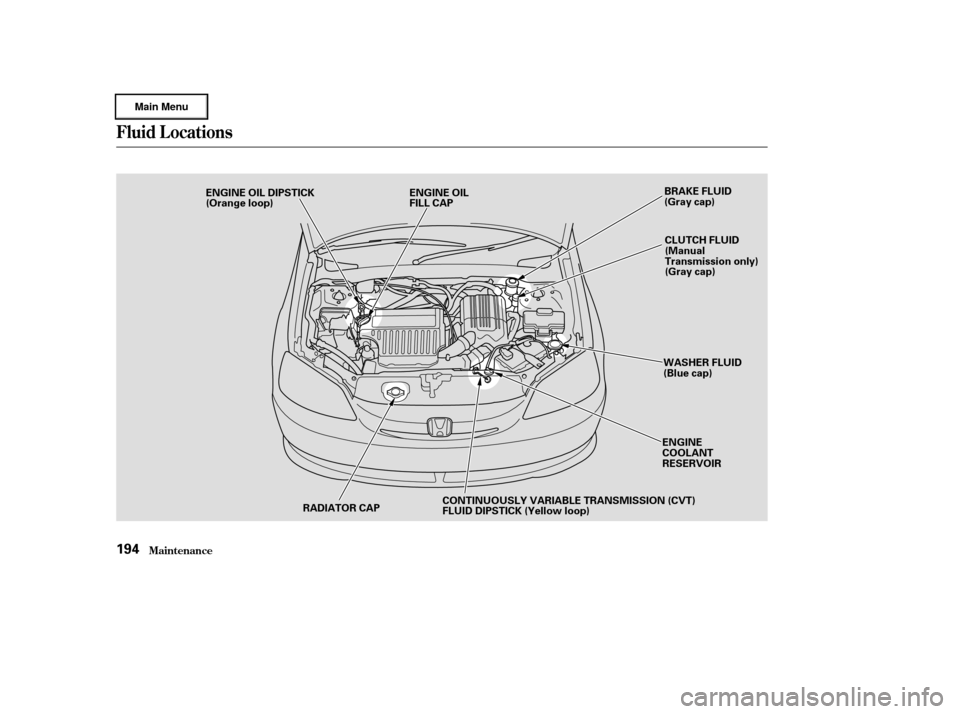
Fluid Locations
Maint enance194
ENGINE OIL DIPSTICK
(Orange loop)ENGINE OIL
FILL CAP BRAKE FLUID
(Gray cap)
CLUTCH FLUID
(Manual
Transmission only)
(Gray cap)
WASHER FLUID
(Blue cap)
ENGINE
COOLANT
RESERVOIR
CONTINUOUSLY VARIABLE TRANSMISSION (CVT)
FLUID DIPSTICK (Yellow loop)
RADIATOR CAP
Page 212 of 317
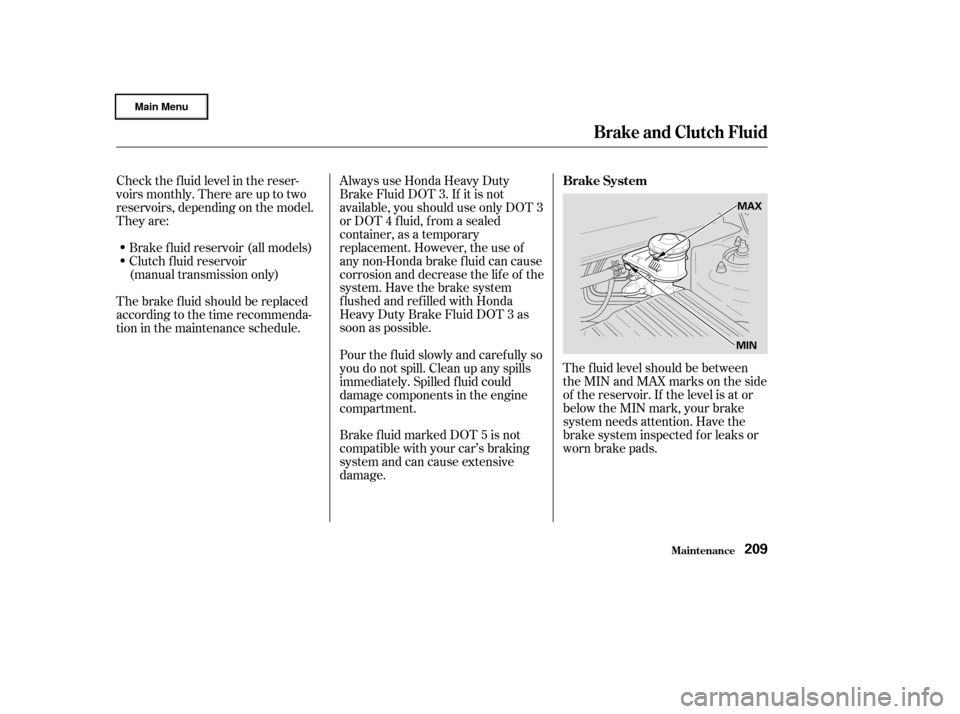
The f luid level should be between
theMINandMAXmarksontheside
of the reservoir. If the level is at or
below the MIN mark, your brake
system needs attention. Have the
brake system inspected f or leaks or
worn brake pads.
Always use Honda Heavy Duty
Brake Fluid DOT 3. If it is not
available, you should use only DOT 3
or DOT 4 f luid, f rom a sealed
container, as a temporary
replacement. However, the use of
any non-Honda brake fluid can cause
corrosion and decrease the lif e of the
system. Have the brake system
f lushed and ref illed with Honda
Heavy Duty Brake Fluid DOT 3 as
soon as possible.
Check the f luid level in the reser-
voirs monthly. There are up to two
reservoirs, depending on the model.
They are:
Brake f luid reservoir (all models)
Clutch f luid reservoir
(manual transmission only)
The brake f luid should be replaced
according to the time recommenda-
tion in the maintenance schedule. Pour the f luid slowly and caref ully so
you do not spill. Clean up any spills
immediately. Spilled f luid could
damage components in the engine
compartment.
Brake f luid marked DOT 5 is not
compatible with your car’s braking
system and can cause extensive
damage.Brake System
Brake and Clutch Fluid
Maint enance209
MAX
MIN
Page 213 of 317
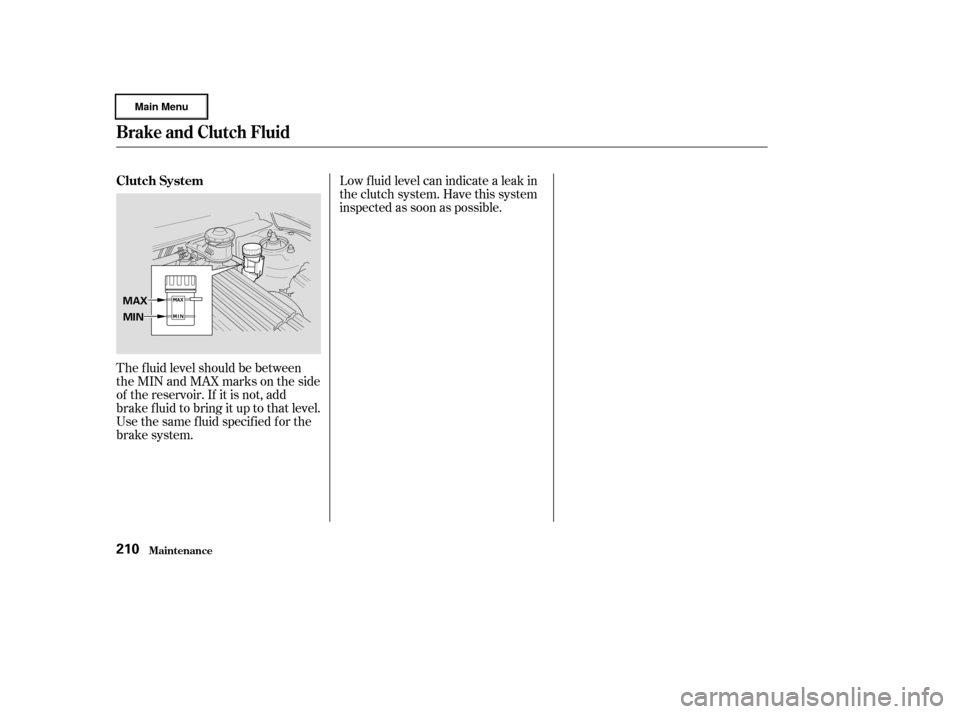
The f luid level should be between
theMINandMAXmarksontheside
of the reservoir. If it is not, add
brake f luid to bring it up to that level.
Use the same fluid specified for the
brake system.Low f luid level can indicate a leak in
the clutch system. Have this system
inspected as soon as possible.
Clutch System
Brake and Clutch Fluid
Maint enance210
MAX
MIN